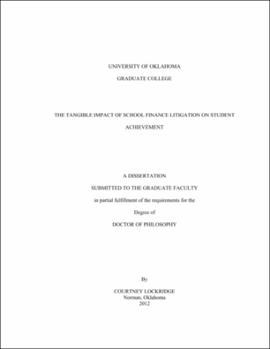| dc.contributor.advisor | Maiden, Jeffrey | |
| dc.creator | Lockridge, Courtney Erin | |
| dc.date.accessioned | 2019-04-27T21:20:49Z | |
| dc.date.available | 2019-04-27T21:20:49Z | |
| dc.date.issued | 2012 | |
| dc.identifier | 9911456402042 | |
| dc.identifier.uri | https://hdl.handle.net/11244/318453 | |
| dc.description.abstract | The purpose of this study was to address the extent to which adequacy litigation functions as a means for improving student achievement, particularly among low income and minority students. The study extended theory established in prior studies and took into account the idea that change takes several years to realize. Another consideration was that sufficient time to fully implement the court's decision and to embark on a mission of reform may not have been possible with the two-year turnaround time provided for in past studies. Six research questions guided the study: | |
| dc.description.abstract | 1. Is there a statistically significant relationship between overall student achievement in reading and math as measured by scaled scores on the fourth and eighth grade National Assessment of Educational Progress (NAEP) and states in which an adequacy lawsuit has been filed? | |
| dc.description.abstract | 2. Is there a statistically significant relationship between overall student achievement in reading and math as measured by scaled scores on the fourth and eighth grade National Assessment of Educational Progress (NAEP) and states that have had a plaintiff victory in an adequacy lawsuit? | |
| dc.description.abstract | 3. Is there a statistically significant relationship between student achievement for students living in poverty in reading and math as measured by scaled scores on the fourth and eighth grade National Assessment of Educational Progress (NAEP) and states in which an adequacy lawsuit has been filed? | |
| dc.description.abstract | 4. Is there a statistically significant relationship between student achievement for students living in poverty in reading and math as measured by scaled scores on the fourth and eighth grade National Assessment of Educational Progress (NAEP) and states that have had plaintiff victory in an adequacy lawsuit? | |
| dc.description.abstract | 5. Is there a statistically significant relationship between student achievement for minority students in reading and math as measured by scaled scores on the fourth and eighth grade National Assessment of Educational Progress (NAEP) and states in which an adequacy lawsuit has been filed? | |
| dc.description.abstract | 6. Is there a statistically significant relationship between student achievement for minority students in reading and math as measured by scaled scores on the fourth and eighth grade National Assessment of Educational Progress (NAEP) and states that have had plaintiff victory in an adequacy lawsuit? | |
| dc.description.abstract | Longitudinal NAEP data was examined to answer the research questions and to contribute to current theory that deals with adequacy, school finance litigation, and student achievement. | |
| dc.format.extent | 133 pages | |
| dc.format.medium | application.pdf | |
| dc.language | en_US | |
| dc.relation.requires | Adobe Acrobat Reader | |
| dc.subject | Academic achievement | |
| dc.subject | Educational equalization--Law and legislation--United States | |
| dc.subject | Education--Finance--Law and legislation--United States | |
| dc.title | The Tangible Impact of School Finance Litigation on Student Achievement | |
| dc.type | text | |
| dc.type | document | |
| dc.thesis.degree | Ph.D. | |
| ou.group | Jeannine Rainbolt College of Education::Department of Educational Leadership and Policy Studies | |
